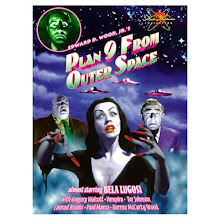by Jason Pyles
“Brazil” was co-written and directed by Terry Gilliam. For those who are unacquainted with Mr. Gilliam, allow me to introduce you:
Somehow Terry Gilliam is simultaneously both the argument for — as well as the argument against — studios allowing a director to have free reign with his or her creative vision. Gilliam is a true artist, indeed, which is to say, his artistic passions often slide off the edge into madness.
Case in point: Among the special features of Gilliam’s “12 Monkeys” DVD, there is a making-of documentary titled “The Hamster Factor and Other Tales of 12 Monkeys.” This documentary’s segment about “the hamster factor” perfectly illustrates an artist like Gilliam’s paradoxical strength and weakness. There is a brief, simple scene that shows Bruce Willis sitting naked. The documentary indicates that this scene should have only taken a few minutes to shoot. But Gilliam insisted on having a hamster running inside a wheel during this scene.
What should have taken 15 minutes ended up taking several hours, thanks to an uncooperative hamster (and a scarily determined director).
Now, anybody who’s ever created anything knows that it’s often the little (unnecessary) details that can give an artist a feeling of satisfaction and ownership. However, the documentary shows us the final product of this scene from “12 Monkeys” and the running hamster is barely visible. If you weren’t looking for it, I believe the hamster would be totally invisible, or at least, indistinguishable. The documentary gives the definite impression that it’s not as important for Gilliam (or his audience) to see this detail as it is for him to simply know it’s there.
Greatness or madness? I think I know, but let’s just say it depends. The studio financing the project will give you one answer; the handsomely paid hamster wrangler would probably give you another. Hard to say. I guess it also depends on the artist: I mean, Orson Welles was basically given carte blanche, and he delivered “Citizen Kane.” Innumerable counter examples also exist. Sure, I lean toward letting the artist freely execute his or her vision, but then, it’s not my money, either.
“The Hamster Effect” documentary, as well as another called “Lost in La Mancha” (2002), shows us that Gilliam is not only obsessive, but he’s also very unlucky. Even the word “cursed” might be appropriate. His bad luck is a whole other discussion for another time and place.
I prefaced my comments on “Brazil” with this Terry Gilliam discussion about the hamster scene because I think it lends us insight into the place where Gilliam is coming from in his films. I’m suggesting that “Brazil” is more autobiographical than you might expect. Think about it — for those who have seen “Brazil” — the protagonist, Sam Lowry (Jonathan Pryce), envisions himself in a much more heroic light than the rest of the world sees him. In his fantasies, he’s a winged warrior of romance and passion, free to fly anywhere he pleases. This surely isn’t much different from how Gilliam must picture himself as a filmmaker.
And Lowry and his love, Jill Layton (Kim Greist), are ominously watched over, restricted and regulated by the Powers That Be, namely a suffocating and controlling government, which has its reasons, namely, counter-terrorism.
How parallel the above paragraph seems to the way Gilliam must surely feel that he and his love (the film in his mind) are ominously watched over, restricted and regulated by the Powers That Be, namely a suffocating studio and board of investors, which have their reasons, namely, financial viability.
…And so forth.
Yes, I agree with Andy that “Brazil” has unmistakable similarities to George Orwell’s book “1984” and to director Michael Radford’s filmic adaptation. So, anybody who’s anti-Big Government will probably love this movie in much the same way.
But to me, the biggest reason to see “Brazil” is to enjoy the chock-full richness of its mise en scène, which basically means everything the camera sees. The art direction and set design are truly something to behold, offering excessive eye-candy. Andy wondered if this film was low-budget, and I should say not. But if it was a low-budget production, that would make it all the more impressive — à la “District 9.”
Even the most casual moviegoer can recognize the look of a Tim Burton film, with all his typical, macabre weirdness. Similarly, Terry Gilliam’s films also seem to have a signature style that’s deeply rooted in mise en scène. In fact, I’d go so far as to say that Gilliam is a master of mise en scène, and I would cite “Brazil” first as evidence. In “Brazil,” even the scenery itself is a character. It carries forth the odd, tonal duality of humor and uneasiness.
So, the next time you’re feeling cinematically adventurous and arty, check out Terry Gilliam’s “Brazil.”






























































No comments:
Post a Comment